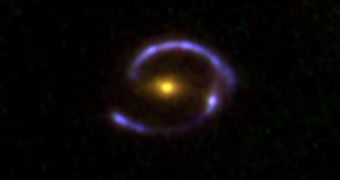The Hubble telescope continues its series of amazing pictures with one that ensured the most accurate analysis of a far galaxy ever performed. The image embedded in this article presents the photography taken by the device, which resembles an eye, or, more precisely, a stylized image of the eye of Ra, the Egyptian god of the sun.
This is not the first time that Hubble captures such eye-like cosmic bodies. On June 22nd, the cloud of dust and gas particles enclosing the tiny Fomalhaut star only 25 light years away from our solar system resembled the red eye of Sauron – if you saw any part of the Lord of the Rings trilogy, you'll know. But the last feat doesn't involve a neighboring star, but quite the opposite – two galaxies, one close and one extremely distant. The former, which represents the "pupil" of the eye, is only 2.2 billion light years away, while the latter, the blue arc that gives the shape of the eye, is, in fact, 11 billion years away, which means it formed about 2 billion years after the Big Bang.
Naturally, you would think that observing this kind of distant objects with so much clarity would be close to impossible. But here's where the physical laws that govern the nature of the universe give us a helping hand. As Einstein predicted, the huge gravity field of the foreground (yellow) galaxy bends the light coming from the far (blue) galaxy in its background, magnifying and brightening it in an effect known as a gravitational lens. As the leader of the study on the farther galaxy – postdoctoral research scholar Dan Stark from Caltech – explains, "Gravity has effectively provided us with an additional zoom lens, enabling us to study this distant galaxy on scales approaching only a few hundred light-years. This is 10 times finer sampling than hitherto possible. As a result, we can see, for the first time, that a typical-sized young galaxy is spinning and slowly evolving into a spiral galaxy much like our own Milky Way."
By studying the spectra and by analyzing the Doppler shift of the galaxy's material, researchers managed to determine its rotation, which indicates that the background cosmic body is a young spiral galaxy (like ours) in formation. Of course, I guess I don't have to stress out for our readers that we see it now as it was 11 billion years ago. Who knows what it may actually look like now? Perhaps, with the advancements in technology, we will be able to find that answer sooner than 11 billion years from now.

 14 DAY TRIAL //
14 DAY TRIAL //